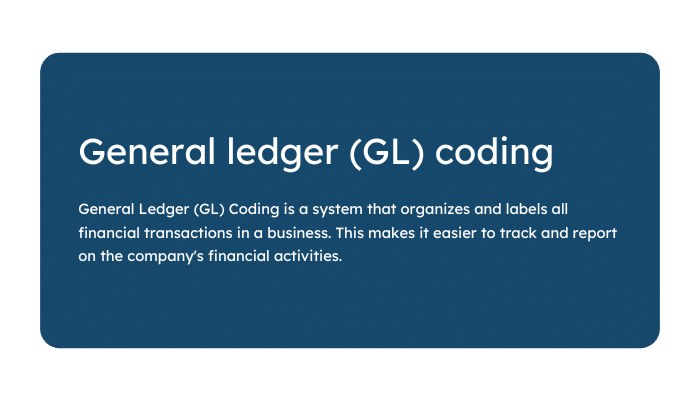General Ledger (GL) Coding is a systematic approach that uses unique alphanumeric codes to classify and track financial transactions in an organization’s general ledger. These codes help businesses accurately record and categorize transactions into various ledger accounts such as revenues, expenses, assets, liabilities, or equity.
Businesses can use GL codes to organize their accounting and enhance accounting accuracy and transparency, making it easier to generate detailed financial reports.
GL codes can include multiple segments, each representing different aspects of a transaction. For example, segments can include departments, account types, or categories. This customization allows organizations to align GL coding structures with their specific accounting practices and reporting needs. Additionally, GL coding helps improve security by providing detailed information about each transaction, thereby identifying potential overspending or fraud.
Key Takeaways
- GL codes are crucial for organizing financial data, accurate financial reporting, and efficiently tracking your company’s financial status.
- Streamlining the GL coding process through accurate transaction categorization and error minimization enhances financial efficiency and decision-making.
- Adopting automated GL coding systems improves your financial management’s efficiency and accuracy, allowing for tailored transaction tracking and aiding in strategic financial planning.
What Is General Ledger Coding?
GL coding helps you organize your accounts receivable and accounts payable so it’s easy to track spending.
GL codes consist of alphanumeric characters, which are assigned to every financial entry in a company’s general ledger. They help you organize and track various transactions within your financial system by categorizing and organizing financial data. This organization makes it easier to navigate financial statements and manage your company’s financial information efficiently.
Reliable financial reporting relies heavily on accurate GL coding. General ledger codes simplify financial statements, giving a transparent snapshot of your company’s financial status during month-end closings.
The general ledger, structured as a chart of accounts, tracks transaction types that include:
- cash
- expenses
- receivables
- payables
Each type has its own unique GL code, ensuring you’re organizing and categorizing transactions correctly to support financial tracking and adhere to compliance standards.
The General Ledger and Its Importance
Your general ledger is a complete record of all your business’s financial transactions. It records everything, from the smallest office supplies expense to the largest revenue account, providing a comprehensive overview of:
- income
- expenses
- assets
- liabilities
The general ledger is essentially your company’s financial biography. It documents every dollar that flows through the company in a clear and organized way so that everyone, including stakeholders, can understand your cash flow and financial position.
Assigning GL Codes to Transactions
Ledger codes classify transactions as accounts receivable or accounts payable, which is essential for efficient organization and data entry. You can break GL codes down even further into sub-categories within accounts, such as projects or vendors, providing a more detailed account structure.
Assigning GL codes is done using a descending numerical system. You’ll start from general categories with large numbers and narrow down to specific transactions with unique numbers to ensure each activity is accurately accounted for.
For example, a retail business would identify its inventory account as a key asset with a specific GL code.
Why You Should Streamline the GL Coding Process
An effective GL coding system lets you closely review transactions and analyze your spending, comparing it against benchmarks and expectations. With this higher level of scrutiny, you can more easily meet business objectives and maintain its financial health.
Transparent reporting of financial positions through accurate GL coding both builds stakeholder confidence and contributes to efficient budget planning by offering insights into:
- departmental spending in comparison to revenue
- cost-saving opportunities
- areas of overspending
- trends in expenses
You can use this information to inform your budgeting, helping to solidify the overall financial stability and success of your organization.
Accurate Financial Data and Informed Decision-Making
GL coding helps you ensure that all financial data is accurately tracked and categorized, creating reliable financial reports that give valuable context to important decisions. If the information is incorrect because of improper GL coding, it misrepresents your business’s financial status and can reduce spending visibility, complicate financial closing processes, and lead to recording and payment errors.
Proper GL coding provides a clearer financial picture that helps you accurately forecast spending, analyze trends to improve your budgeting, and clarify your financial status. This added insight is essential for informed decision-making and fraud prevention, which helps improve efficiency.
Reducing Manual Data Entry Errors
Human data entry is naturally prone to mistakes that can significantly disrupt your financial management. While you can leverage a document management system like DocuWare to significantly decrease manual data entry errors, you still need to be sure that these imported transactions are accurately categorized.
Approximately 20% of shipments have incorrect GL coding, which minimizes spending visibility, creates payment errors, and complicates closing processes. Fortunately, smart GL coding practices add oversight that ensures you’re categorizing each transaction correctly to avoid these costly mistakes.
The Benefits of Automating GL Coding
Automating GL coding can save you time and money by reducing labor costs from manual data entry, minimizing mistakes that paint an inaccurate financial status, and allowing you to make better-informed decisions with accurate financial data.
When you use AI and automation to streamline your financial management, you can have more confidence in your financial health. With higher confidence, you can focus on making big-picture decisions that move your business forward.
Selecting the Right GL Code Software
Your GL code accounting software should offer robust coding automation to ensure transactions are correctly reported in the general ledger. The software should be able to recognize and organize transactions by analyzing key fields from previously coded invoices, allowing the system to learn and improve its accuracy over time for more precise financial reporting.
Luckily, Zero Down’s Freight Audit and Payment process does just that. Automating your GL codes, allocating costs at the SKU level based on your rules, and comparing charges against expected amounts allows it to highlight and help explain any discrepancies so they can be easily reconciled.
Implementing Automated GL Coding
Freight audit and payment software automates GL coding by pre-coding invoices, leading to increased tracking precision and fewer errors. This results in a more streamlined and efficient GL coding process, which creates a clear financial picture and simplifies financial management.
How to Adapt GL Coding to Your Business Needs
GL coding acts as a general framework for how your business’s financial transactions are categorized. They utilize a descending hierarchy from broad categories to specific transactions, which helps you improve the tracking of financial activities relevant to different business areas.
You can make GL coding work for your business by assigning unique GL codes to specific transactions and creating sub-categories. This hierarchy provides a more clear understanding of departmental expenses and specific line-level spend, which offers valuable insight into your costs that you can use to optimize your budgeting.
How Automating GL Coding Clarified A Company’s FAP
A Zero Down client was having issues keeping track of their transactions through another provider, making it difficult to optimize their spending and reconcile payments with carriers. Fortunately, this lack of visibility was resolved by automating their GL coding so they could audit their transactions quickly, identify costs, and send timely payment times to keep carriers and stakeholders happy.
Leverage General Ledger Coding to Optimize Your Accounting
Mastering GL coding is the key to reliable and actionable financial management. GL codes help you understand how to categorize, organize, and track every financial transaction in your company so you can accurately report your financial status, make well-informed decisions, and optimize your cash flow management.
Effective GL coding requires the right software that automates data entry, accurately categorizes your transactions according to your code structure, and paints a clear picture of your business’s financial health at all times. Without it, you’ll end up spending more time and money on your daily workflows and financially-informed decisions.
Frequently Asked Questions
What is general ledger coding, and why is it important?
GL coding is a hierarchy that determines how you categorize and organize financial transactions. It supports financial tracking and ensures compliance with financial management standards by assigning alphanumeric characters to entries in your company’s general ledger that clearly outline the nature of the transaction.
How is the general ledger important to a business?
The general ledger is important to your business because it provides a comprehensive record of all financial transactions. It allows for accurate income, expense, asset, and liability tracking, to serve as the basis for financial reporting.
How can a business streamline its GL coding process?
You can streamline the GL coding process by minimizing manual data entry errors and automating the precise categorization of transactions based on your clear GL coding practices to improve efficiency.
How can a business adapt GL coding to its specific needs?
You can adapt GL coding to your specific business needs by customizing the GL coding structure with a descending hierarchy from broad categories to specific transactions with code segments that clearly assign each value to a piece of information, allowing better tracking of financial activities relevant to different business areas.
Brad McBride, CEO and Founder of Zero Down Supply Chain Solutions is a dynamic leader with over 30 years of experience in the supply chain sector. His journey began at Consolidated Freightways in 1988, where he mastered freight logistics and pricing. His career led him to Eagle Global Logistics, diving into international freight forwarding and leading high-volume shipping projects.
Read More







